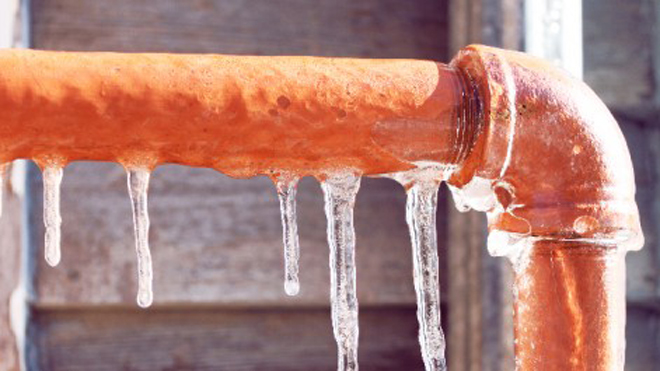Crucial Advice to Avoid Frozen Plumbing in Cold Weather
Crucial Advice to Avoid Frozen Plumbing in Cold Weather
Blog Article
What're your ideas on Helpful Tips to Prevent Frozen Pipes this Winter?

Cold weather can damage your plumbing, particularly by freezing pipes. Right here's exactly how to prevent it from taking place and what to do if it does.
Introduction
As temperature levels decrease, the risk of frozen pipelines increases, possibly causing costly repair services and water damages. Comprehending just how to prevent icy pipes is critical for property owners in cool climates.
Understanding Frozen Pipes
What triggers pipes to ice up?
Pipes ice up when exposed to temperatures below 32 ° F (0 ° C) for expanded durations. As water inside the pipes ices up, it expands, putting pressure on the pipe walls and possibly triggering them to burst.
Dangers and damages
Frozen pipelines can bring about water supply disturbances, building damages, and costly repair work. Ruptured pipelines can flooding homes and cause substantial structural damage.
Indications of Frozen Pipeline
Determining frozen pipes early can stop them from bursting.
How to determine frozen pipelines
Look for lowered water flow from taps, unusual smells or noises from pipelines, and noticeable frost on subjected pipelines.
Prevention Tips
Shielding at risk pipes
Wrap pipelines in insulation sleeves or make use of heat tape to protect them from freezing temperature levels. Focus on pipes in unheated or outside locations of the home.
Home heating strategies
Keep interior spaces appropriately warmed, especially areas with plumbing. Open cabinet doors to allow cozy air to distribute around pipelines under sinks.
Safeguarding Outside Plumbing
Yard hose pipes and exterior taps
Separate and drain pipes yard pipes prior to winter season. Install frost-proof spigots or cover outdoor faucets with shielded caps.
What to Do If Your Pipes Freeze
Immediate activities to take
If you think frozen pipes, maintain faucets open to soothe stress as the ice thaws. Utilize a hairdryer or towels taken in hot water to thaw pipelines slowly.
Long-Term Solutions
Architectural modifications
Consider rerouting pipes far from outside wall surfaces or unheated areas. Include additional insulation to attic rooms, basements, and crawl spaces.
Upgrading insulation
Buy high-grade insulation for pipes, attics, and wall surfaces. Proper insulation helps keep regular temperatures and decreases the threat of frozen pipes.
Final thought
Protecting against icy pipelines requires proactive measures and fast responses. By comprehending the reasons, indications, and preventive measures, property owners can protect their pipes throughout cold weather.
6 Proven Ways to Prevent Frozen Pipes and Protect Your Home
Disconnect and Drain Garden Hoses
Before winter arrives, start by disconnecting your garden hoses and draining any remaining water. Close the shut-off valves that supply outdoor hose bibs and leave the outdoor faucet open to allow any residual water to drain. For extra protection, consider using faucet covers throughout the colder months. It’s also important to drain water from any sprinkler supply lines following the manufacturer’s directions.
Insulate Exposed Pipes
Insulating your pipes is an effective way to prevent freezing. Pipe insulation is readily available at home improvement stores and is relatively inexpensive. Pay close attention to pipes in unheated areas such as the attic, basement, crawl spaces, or garage. Apply foam insulation generously to create a buffer against the cold. You can also wrap your pipes in heat tape or thermostat-controlled heat cables for added warmth.
Seal Air Leaks
Inspect your home for any cracks or openings that could let in cold air. Seal any holes around the piping in interior or exterior walls, as well as the sill plates where your home rests on its foundation. Additionally, make sure to keep your garage door closed unless you’re entering or exiting. Leaving it open creates a significant air leak that can lead to frozen pipes.
Allow Warm Air Circulation
During cold snaps, it’s essential to allow warm air to circulate evenly throughout your home. Leave interior doors ajar to promote better airflow. Open kitchen and bathroom cabinets to help distribute heat consistently around the rooms. If you have small children or pets, be sure to remove any household chemicals or potentially harmful cleaners from open cabinets for safety.
Let Faucets Drip
A small trickle of water can make a big difference in preventing ice formation inside your pipes. When temperatures drop significantly, start a drip of water from all faucets served by exposed pipes. This continuous flow helps prevent the water from freezing. Additionally, running a few faucets slightly can relieve pressure inside the pipes, reducing the chances of a rupture if the water inside does freeze.
https://choateshvac.com/6-proven-ways-to-prevent-frozen-pipes-and-protect-your-home/

Do you like more info about Helpful Tips to Prevent Frozen Pipes this Winter? Try to leave a remark down the page. We will be delighted to find out your insights about this write-up. We hope that you visit us again in the future. Liked our post? Please quickly share it. Let others locate it. We treasure reading our article about 6 Ways to Prevent Frozen Pipes.
Go Deal Now Report this page